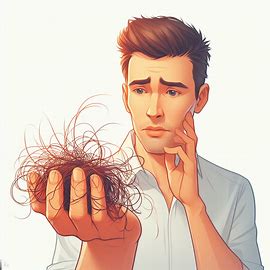
Finasteride and minoxidil are the only two medications that are FDA approved for the treatment of hair loss.
Both work through different mechanisms of actions, and both can also cause unexpected temporary hair shedding episodes.
Finasteride and Minoxidil Hair Shedding
- Finasteride:
- Mechanism of Action: Finasteride (Propecia brand name) is an oral medication that belongs to the class of drugs known as 5-alpha-reductase inhibitors. It works by inhibiting the action of the enzyme 5-alpha-reductase, which converts testosterone into dihydrotestosterone (DHT). DHT is implicated in the miniaturization of hair follicles in individuals who are genetically predisposed to androgenetic alopecia (AGA — aka male pattern baldness). Note that topical finasteride is also becoming very popular.
- Hair Shedding: Some users may experience an initial increase in hair shedding during the first few months of finasteride treatment. This phenomenon (almost like telogen effluvium) is thought to occur as the drug affects the hair growth cycle. In particular, the anagen growth phase is increased. Shedding is usually temporary, and most individuals observe regrowth and stabilization of hair loss after this initial phase.
- Minoxidil:
- Mechanism of Action: Minoxidil (Rogaine brand name) is a topical medication that is applied directly to the scalp. While its exact mechanism of action is not fully understood, it is believed to promote blood flow to the hair follicles. This in turn prolongs the anagen (growth) phase of the hair cycle, increasing follicle length and thickness. Higher strength doses of minoxidil 10% and 15% are also available with prescription. Note that oral minoxidil is also becoming very popular.
- Hair Shedding: Similar to finasteride, some users may experience an initial increase in hair shedding when starting minoxidil treatment. This shed phase is temporary and is often considered a sign that the medication is beginning to take effect. It is followed by a period of regrowth and stabilization of hair loss.
Summary
- Shedding with both finasteride and minoxidil is usually transient and is not an indication that the treatment is ineffective.
- These medications require consistent and long-term use to realize their benefits. Do not get scared with the temporary increase in hair fall.
- It is crucial to consult with a healthcare professional before starting any hair loss treatment to determine the most suitable approach. And to address any potential side effects or contraindications.
Up until very recently, the normal delivery of Minox has been topical and Finasteride, oral. Now that Minox is available in pill form and Finasteride, topically, I wonder if we can see if there is a difference in hair shedding with the two different forms of delivery?